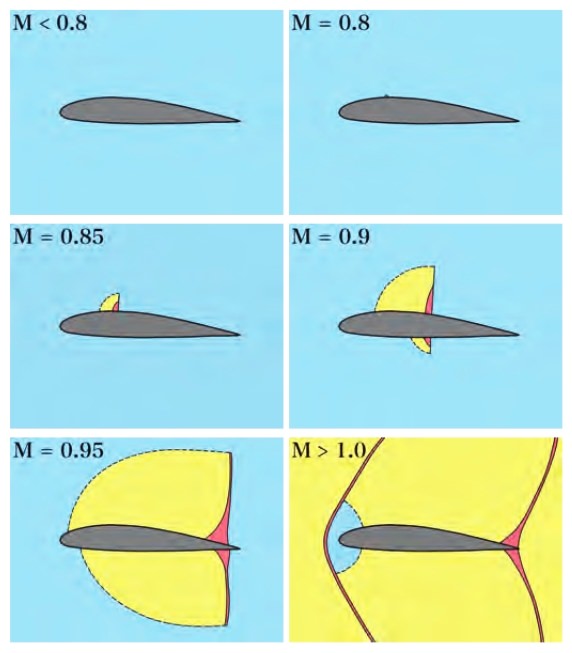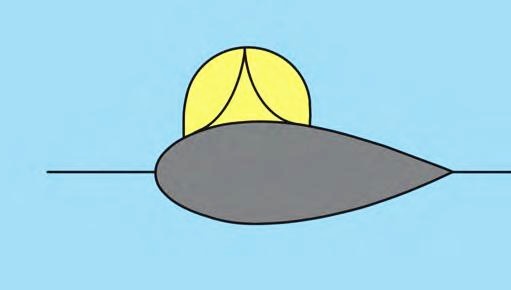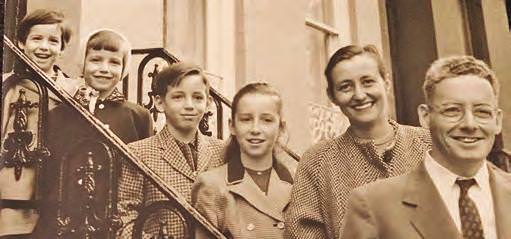by Kevin R. Payne

The work of Cathleen Morawetz on transonic fluid flow and the underlying PDEs of mixed elliptic-hyperbolic type spanned her career. Here we describe her earliest work. Beginning in the mid 1950s, Morawetz began working on transonic flow problems through her interactions with Kurt O. Friedrichs and Lipman Bers. This problem area was ripe for the unique blend of joyous ingenuity and practical tenacity which characterized her approach to happily doing mathematics in order to say something about a real world problem. Morawetz quickly made a name for herself by giving a mathematical answer to an important engineering question in transonic airfoil design.
Morawetz periodically returned to this area with bursts of productivity that resulted in fundamental contributions over the next five decades. The photo of Morawetz in 1958 shows the happy face that Morawetz would display when discussing what interested her most. It was with the same gentle smile and glint in the eyes that she might also show her warm toughness and attachment to physical relevance when liquidating a night’s calculations of a collaborator with a phrase like: “You know, the solutions should not really behave this way. Let’s change the equation.”
What is transonic flow about?

In aerodynamics, a basic question is: How does one fly at a relatively high speed, with relatively low cost and relatively low ecological damage? In Morawetz’s 1982 article in the Bulletin of the AMS, she described the problem as follows. The science of flight depends on the relative speed of the aircraft with respect to the speed of sound in the surrounding air. At relatively low speeds, the subsonic range, one can “sail” by designing wings to “get as much as possible of a free ride” from the wind. At very high speeds, the supersonic range, one needs “rocket propulsion” to overcome the drag produced by shocks that invariably form (the sonic boom). The goal of studying transonic flow is to find a compromise which allows for “sailing” efficiently “near the speed of sound.” Shocks produce drag, which increases fuel consumption and hence increases cost. As seen in Figure 7, shocks (colored red) begin to appear on airfoils in wind tunnels when the upstream velocity is below, but near the speed of sound.
The 2-D irrotational, stationary, compressible and isentropic flow of air about a profile \( P \) is governed by an equation for the potential \( \phi(x, y) \) whose gradient is the velocity field of the fluid with variable density \( \rho \): \begin{equation} \label{seventeen} (c^2 - \varphi^2_x) \varphi_{xx} - 2\varphi_x \varphi_y \varphi_{xy} + (c^2 - \varphi^2_y ) \varphi_{yy} = 0. \end{equation} The natural boundary condition is to have normal derivative \begin{equation} \label{eighteen} \frac{\partial\varphi}{\partial n} = 0 \quad\text{on } \partial P. \end{equation} The nature of the flow is determined by the local Mach number \( M = q/c \) where \( q = |\nabla \varphi| \) is the flow speed and \( c > 0 \) is the local speed of sound defined by \( c^2 = \partial p/\partial \rho \), where the adiabatic pressure density relation in air is \( p = p(\rho) \sim \rho^{\gamma} \) with \( \gamma \approx 1.4 \). Observe that equation \eqref{seventeen} is of the form \[ A\varphi_{xx} - 2B\varphi_{xy} + C\varphi_{xx}. \] It is elliptic when \[ AC - B^2 > 0, \] which occurs at points where the flow is subsonic \( (q < c) \). It is hyperbolic when \[ AC - B^2 < 0, \] which occurs at points where the flow is supersonic \( (q > c) \) (see Figure 7). A transonic flow happens when there are both sub- and supersonic regions and the equation \eqref{seventeen} is of mixed elliptic-hyperbolic type.
The presence of shocks in supersonic regions corresponds to drastic changes in air density and pressure coming from the compressibility, and these large pressure changes propagate at supersonic speeds, resulting in a shock wave which typically has a small but finite thickness. In Figure 7, the shock wave region is depicted in red. The velocity field \( \nabla\varphi \) governed by \eqref{seventeen} will experience jump discontinuities as one crosses the shock wave. One can use the presence of such discontinuities to detect the presence of shocks. The mathematical description of shocks requires a separate analysis of entropy effects, where equation \eqref{seventeen} has broken down.
The transonic controversy
By the time of the Third International Congress for Applied Mechanics in 1930, a lively debate centered around the question: Do transonic flows about a given airfoil always, never, or sometimes produce shocks? In particular, is it possible to design a viable airfoil capable of shock-free flight at a range of transonic speeds? Contrasting evidence was presented at the congress which led many aerodynamicists to take opposing views. G. I. Taylor presented convergent Rayleigh series expansions for the velocity potential of some smooth transonic flows, while A. Busemann presented the results of wind tunnel experiments that indicated the presence of a lot of shocks. World War II moved attention to rocket propulsion. An answer would await the work of Morawetz in the 1950s. It was a case of “mathematics coming to the rescue.”
Morawetz’s answer to the transonic controversy
In a series of papers published in 1956–58 in Comm. Pure Appl. Math., Morawetz gave a mathematical answer by proving that shock-free transonic flows are unstable with respect to arbitrarily small perturbations in the shape of the profile. Her theorem says that even if one can design a viable profile capable of a shock-free transonic flow, imperfection in its construction will result in the formation of shocks at the design speed.
Let \( \varphi \) be a transonic solution to \eqref{seventeen}–\eqref{eighteen} with continuous velocity field \( \nabla\varphi \) and fixed speed \( q_{\infty} \) at infinity about a symmetric profile \( P \) as in Figure 8. For an arbitrary perturbation of \( \widetilde{P} \) along an arc inside the supersonic region attached to the profile which contains the point of maximum speed in the flow, there is NO continuous \( \nabla\tilde{\varphi} \) solving the corresponding problem \eqref{seventeen}–\eqref{eighteen} with \( \widetilde{P} \).

Morawetz’s proof involved two major steps. First, she determined the correct boundary value problem satisfied the perturbation of the velocity potential in the hodograph plane where a hodograph transformation linearizes the PDE \eqref{seventeen} and sends the known profile exterior into an unknown domain. Then, using carefully tailored integral identities, she proved a uniqueness theorem for regular solutions of the transformed PDE with data prescribed on only a proper subset of the transformed boundary profile, which says that the transformed problem is overdetermined and no regular solutions exist. Morawetz extended this result to include fixed profiles but finite perturbations in \( q_{\infty} \), and the extension to nonsymmetric profiles was carried out by L. Pamela Cook (Indiana Univ. Math. J., 1978).
Engineering impact

Mathematical impact
Cathleen Morawetz’s early work on transonic flow both transformed the field of mixed-type partial differential equations and served as excellent publicity for mathematics. Commenting on the transonic controversy in 1955, the celebrated aerodynamicist Theodore von Kármán observed: “…the mathematician may exactly prove existence and uniqueness of solutions in cases where the answer is evident to the physicist or engineer…On the other hand, if there is really serious doubt about the answer, the mathematician is of little help.” Morawetz’s surprising theorem on the nonexistence of smooth flows was a cheerful response to von Kármán’s well-intentioned challenge.
Having settled the engineering question about the “exceptional nature” of shock-free transonic flows, Morawetz turned to related questions: Can one prove robust existence theorems for weak shock solutions? Can one “contract” a weak shock to a sonic point on the profile? The first question was supported by work of Garabedian–Korn in 1971, which demonstrated that small perturbations of continuous flows can have only weak shocks. The second question was inspired by the thinking of K. G. Guderley in the 1950s. Morawetz took two very different approaches to such questions.
Taking a singular perturbation with a hodograph transformation, the questions reduce to proving the existence of weak solutions to the Dirichlet problem for linear mixed-type equations on domains \( \Omega \) in the hodograph plane: \begin{alignat}{2} K(\sigma)\psi_{\theta\theta} + \psi_{\sigma\sigma} &= f &\quad &\text{in } \Omega,\\ \text{and }\quad \psi& =0 &\quad &\text{on } \partial\Omega, \end{alignat} where \( K(\sigma) \sim\sigma \) as \( \sigma \rightarrow 0 \). Here \( \psi \) is the stream function of the flow, \( \sigma \) is a logarithmic rescaling of the flow speed which is sonic at \( \sigma = 0 \), and \( \theta \) is the flow angle. For special domains, Morawetz [Comm. Pure Appl. Math. 1970] proved the surprising result of the existence of a unique weak solution to the problem.
Inspired by the differencing method of Jameson, Morawetz introduced an artificial viscosity parameter \( v \) into the nonlinear potential equation by replacing the (inviscid) Bernoulli law \[ \rho = \rho_B (|\nabla\varphi|) \] with a first-order PDE which retards the density \( \rho \). An ambitious program ensued in order to prove the existence of weak solutions to the inviscid problem as a weak limit of viscous solutions. Powerful but delicate tools in the application of the compensated compactness method of F. Murat, L. Tartar, and R. Di Perna were applied with success to complete parts of the program in Morawetz [Comm. Pure Appl. Math. 1985, 1991] and Gamba–Morawetz [Comm. Pure Appl. Math. 1996].

During the period 1952–2007, Morawetz produced 22 deep research papers and 10 survey papers on transonic flow and mixed-type partial differential equations. She was an exemplary figure of the applied mathematician “who proves theorems to solve problems.” Morawetz discovered and implemented a wide variety of tools to handle the complexity of mixed-type PDEs. She developed energy methods and important identities by the skillful and ingenious use of multiplier methods championed by K. Friedrichs [Comm. Pure Appl. Math. 1958] and found surprising maximum principles which were calibrated to invariances in the equation.
The legacy of Cathleen Morawetz includes her dedication to the proposition that “there is no such thing as a distant relative,” which she applied to every part of her well-lived life. Her grace, warmth and generosity to generations of mathematicians working in the area will be long remembered. She was a truly inspirational figure who invited us all to “sail with her, near the speed of sound.”1